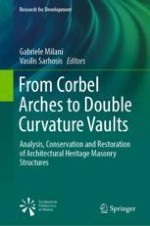The book focuses on all typological aspects of arches and vaults within the heritage of design and construction, while bringing attention to new “green” materials, promoting a circular economy informed by limitations caused by global warming. The multidisciplinary approach involves several different competences in architecture, structural engineering, conservation and restoration, geomatics, BIM, building engineering, the technology and history of construction, graphical methods of assessment, and innovative design that utilizes non-polluting materials. After an overview of the technical and aesthetic advantages of masonry vaults, there is a review of the most up-to-date trends in historic preservation. Classic methods of static assessment and innovative building technologies are detailed. Surveying methods and data acquisition are discussed, particularly laser scanning technology and its applications in heritage masonry curved structures. Next comes the experimental static and dymanic behavior of masonry vaults, followed by a critical revision of Distinct Element innovative computerized Methods. An explanation as to how to pass from classic stability analysis to an adaptive Finite Element Method limit analysis procedure is offered. Reinterpretation of the past is then undertaken, with an eye towards emphasizing sustainability. Finally, the conclusion examines still existing gaps in knowledge and recommends avenues of future research.
